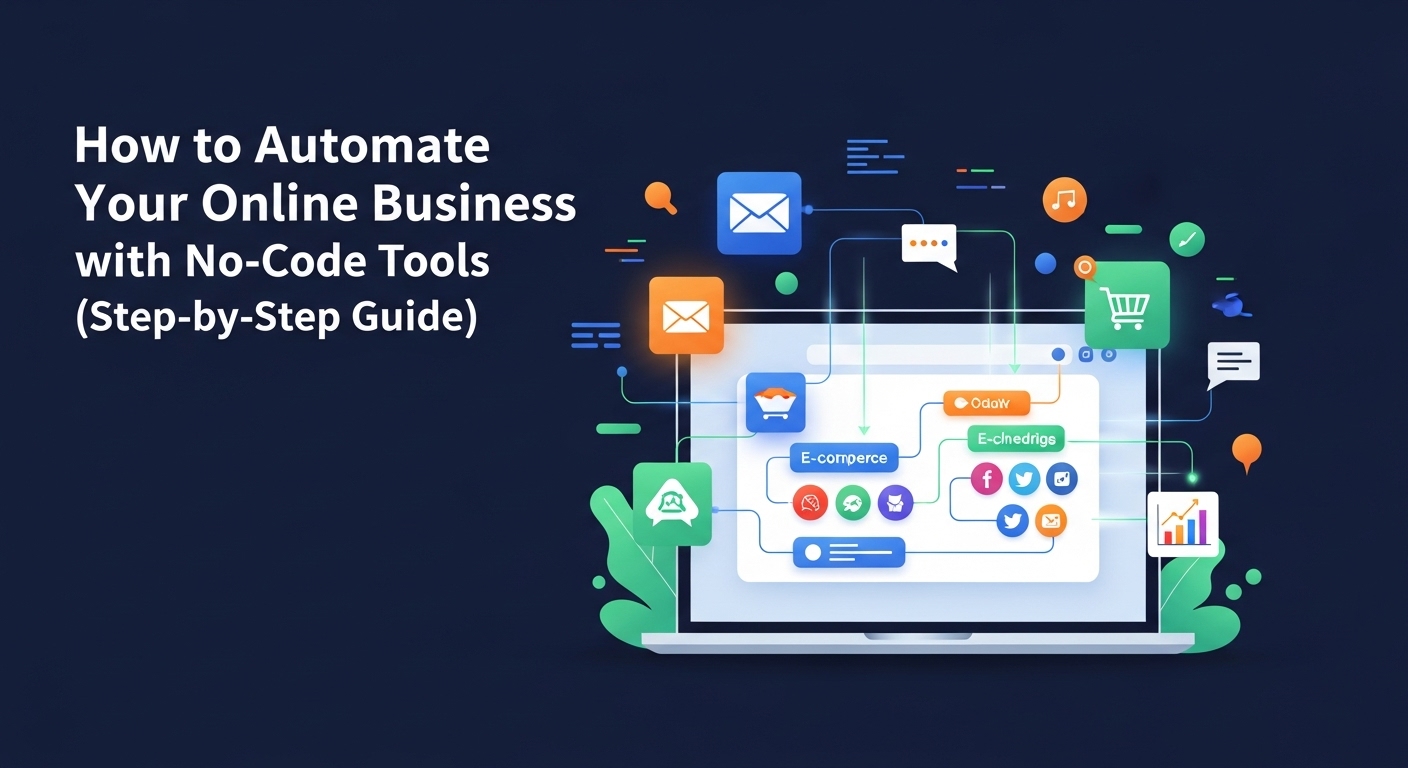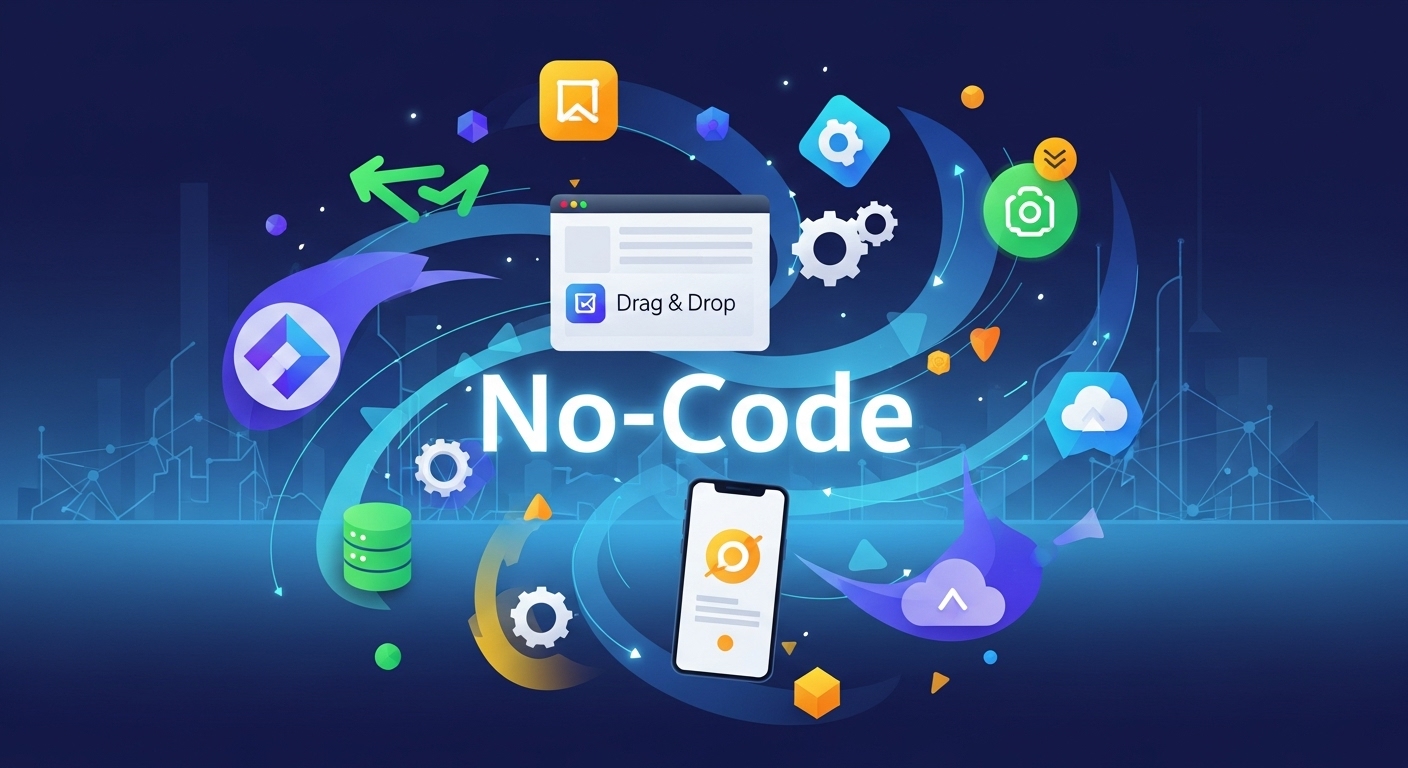Are You Drowning in Repetitive Tasks? There’s a Better Way.
Running an online business is a dream for many, but the reality often involves being buried under a mountain of small, repetitive, and time-consuming tasks. From manually entering customer data and sending follow-up emails to posting on social media and managing invoices, the daily grind can steal your focus from what truly matters: growing your business. What if you could put these tasks on autopilot? What if you could build efficient systems that work for you 24/7, even while you sleep? That’s not a far-off dream; it’s the power of automation, and thanks to a new wave of accessible technology, you don’t need to be a programmer to harness it. Welcome to the world of no-code automation.
This comprehensive guide will walk you through, step-by-step, how to automate your online business. We’ll explore what no-code & automation tools are, why they are a game-changer for entrepreneurs, and how you can start implementing them today to reclaim your time, reduce errors, and scale your operations like never before.
What Exactly Are No-Code & Automation Tools?
Before we dive into the ‘how,’ let’s clarify the ‘what.’ The terms might sound technical, but the concepts are surprisingly simple and empowering.
Breaking Down ‘No-Code’
No-code platforms are software development tools that allow you to build applications, websites, and workflows using a visual, drag-and-drop interface instead of writing traditional programming code. Think of it like building with LEGO blocks. You have pre-built components (blocks) that you can connect in various ways to create something functional and unique. You don’t need to know how to manufacture the plastic for each LEGO piece; you just need to know how to fit them together. This approach democratizes technology, putting the power to create in the hands of marketers, entrepreneurs, and business owners—not just developers.
Understanding ‘Automation’
Automation, in this context, is the process of setting up software to perform a series of tasks automatically based on specific triggers. The basic formula for any automation is: “When This Happens (Trigger), Do That (Action).” For example:
- Trigger: A customer makes a purchase on your Shopify store.
- Action: Automatically add that customer’s email to your Mailchimp newsletter list.
By chaining these simple ‘if-this-then-that’ rules together, you can create complex, multi-step workflows that handle significant parts of your business operations without any manual intervention.
The Magic Combination
When you combine these two concepts, you get no-code & automation tools—user-friendly platforms that let you connect your favorite apps and services to automate tasks. Tools like Zapier, Make, and Pabbly Connect act as the digital glue for the internet, enabling seamless communication between platforms that weren’t originally designed to speak to each other.
Why Automate? The Transformative Benefits for Your Business
Implementing automation isn’t just about convenience; it’s a strategic move that can fundamentally change how your business operates and grows.
Reclaim Your Most Valuable Asset: Time
Imagine all the hours you spend each week on administrative tasks. Data entry, sending reminder emails, updating spreadsheets, posting content—it all adds up. Automation takes these tasks off your plate, freeing you up to focus on high-impact activities like product development, marketing strategy, and building customer relationships. This isn’t just a small time-saver; it’s a massive shift in how you allocate your energy.
Drastically Reduce Costly Human Errors
To err is human, but in business, errors can be costly. A typo in an email address can lose a lead. A missed invoice can affect cash flow. A forgotten follow-up can kill a sale. Automated workflows are consistent and reliable. They perform the same task perfectly every single time, eliminating the risk of manual mistakes and ensuring a higher level of accuracy across your operations.
Scale Your Operations Without Scaling Your Headcount
How do you handle ten times the number of orders or clients? For many businesses, the answer is hiring more people, which increases overhead. Automation allows you to scale your capacity without a proportional increase in costs. An automated onboarding sequence works just as well for one new client as it does for one hundred. This creates a more efficient, lean, and scalable business model.
Enhance the Customer Experience
Automation can create a more responsive and personalized experience for your customers. From instant welcome emails and order confirmations to timely follow-ups and support ticket acknowledgments, automation ensures your customers feel seen and valued at every touchpoint. This consistency builds trust and loyalty, which are essential for long-term success.
Your Step-by-Step Guide to No-Code Automation
Feeling inspired? Let’s get practical. Here’s how you can start implementing automation in your online business, one step at a time.
Step 1: Identify and Prioritize Repetitive Tasks
You can’t automate what you don’t measure. The first step is to become an observer of your own work. For one week, keep a log of all your tasks. Pay close attention to the ones that are:
- Repetitive: Do you do this every day or every week? (e.g., checking for new leads and adding them to a spreadsheet).
- Rule-based: Does the task follow a clear set of rules? (e.g., if a customer fills out a contact form, send them a brochure).
- Time-consuming but low-value: Does it take up a lot of time without requiring strategic thinking? (e.g., copy-pasting data between two applications).
Your ‘automation hit list’ might include things like: managing social media, onboarding new clients, processing orders, sending invoices, or nurturing leads.
Step 2: Choose the Right No-Code & Automation Tools
The market is filled with incredible tools, but you don’t need all of them. Start with a core set.
- Integration Platforms (The Hub): These are the most critical. They connect all your other apps. The top players are Zapier and Make (formerly Integromat). Zapier is known for its simplicity and vast library of app integrations, while Make offers more visual complexity and power for advanced workflows.
- Email Marketing: Tools like Mailchimp, ConvertKit, or ActiveCampaign are essential for automating your communication with leads and customers.
- Project Management & Databases: A tool like Airtable or Notion can act as a central database for your business, while Trello or Asana can automate task creation and assignment.
- Forms & Surveys: Use Typeform or Jotform to collect information that can trigger powerful automations.
Step 3: Build Your First Simple Automation
Start small to build confidence. Pick a simple, low-risk task from your list. A classic first automation is saving email attachments to cloud storage.
Example Workflow: Save Gmail Attachments to Google Drive
- Choose your tool: Let’s use Zapier.
- Set the Trigger: Select Gmail as the app. The trigger event will be ‘New Attachment’. You’ll specify criteria, like only looking for attachments from a specific sender or with a certain keyword in the subject line.
- Set the Action: Select Google Drive as the app. The action event will be ‘Upload File’.
- Connect the dots: You’ll tell Zapier to take the file from the Gmail attachment (the trigger) and upload it to a specific folder in your Google Drive (the action).
- Test and turn it on: Zapier will run a test to make sure it works. Once confirmed, you can turn your ‘Zap’ on, and it will run silently in the background forever.
Congratulations! You just built your first automation and saved yourself future clicks and drags.
Step 4: Map and Build a More Complex Workflow
Once you’re comfortable, you can tackle a more impactful business process. Let’s map out a lead nurturing workflow.
Goal: When someone downloads a free guide from your website, automatically add them to your CRM, send them a welcome email, and schedule a follow-up.
- Trigger: A new submission in your website form (e.g., Typeform).
- Action 1 (CRM): In Zapier/Make, connect Typeform to Airtable. Create a new record in your ‘Leads’ database with the person’s name and email.
- Action 2 (Email): Add another step. Connect to Mailchimp. The action is to ‘Add/Update Subscriber’ to a specific audience and tag them as ‘Downloaded Guide’. This can trigger an automated welcome email sequence you’ve already set up in Mailchimp.
- Action 3 (Task Management): Add a final step. Connect to Asana. The action is to ‘Create a Task’ assigned to you, with a due date three days from now, titled ‘Follow up with [Lead Name]’.
With this one workflow, you’ve seamlessly captured a lead, started nurturing them via email, and ensured you won’t forget to follow up personally—all without lifting a finger after the initial setup.
Step 5: Test, Monitor, and Refine
Automation is powerful, but it’s not infallible. Always test your workflows thoroughly before relying on them. Most automation platforms have a history log where you can see every time a workflow has run, successfully or not. Check this log periodically to catch errors. As your business evolves, your processes will too. Revisit your automations quarterly to see if they can be improved or if new opportunities for automation have emerged.
Conclusion: Your Future is Automated
The barrier to creating a highly efficient, automated online business has never been lower. You no longer need a massive budget or a team of developers to build the systems that will help you grow. By embracing no-code & automation tools, you can take back control of your time, deliver a superior customer experience, and build a business that is truly scalable.
The journey starts with a single step. Look at your to-do list for today. What is the one repetitive task you could eliminate forever? Go build your first automation. It might just be the most productive thing you do all year.


